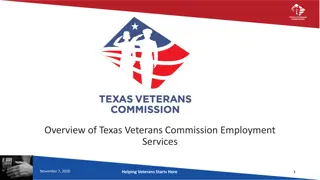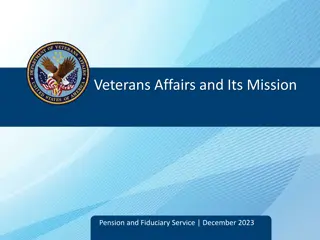Supporting Veterans in Long-Term Care Program Overview
The program outlines the historical context, long-term care settings, and the support provided to veterans in community and contract beds. It details the Department's role, program eligibility, accommodation, meals, challenges, and decision-making processes. Historical support traces back to 1915, with a focus on veterans' access to care facilities. Most veterans are supported in community beds, with the Department covering the cost difference. Contract beds are designated for Second World War and Korean War veterans, ensuring priority access.
Download Presentation

Please find below an Image/Link to download the presentation.
The content on the website is provided AS IS for your information and personal use only. It may not be sold, licensed, or shared on other websites without obtaining consent from the author.If you encounter any issues during the download, it is possible that the publisher has removed the file from their server.
You are allowed to download the files provided on this website for personal or commercial use, subject to the condition that they are used lawfully. All files are the property of their respective owners.
The content on the website is provided AS IS for your information and personal use only. It may not be sold, licensed, or shared on other websites without obtaining consent from the author.
E N D
Presentation Transcript
SUPPORTING VETERANS IN LONG TERM CARE Care and Support Advisory Group July 26, 2017
Objective To provide an overview of the Long Term Care Program Outline Historical Context Long Term Care Settings Authority & Program Eligibility How Does It Work Accommodation and Meals Current Situation Future Projections Application and Decision Making Process Challenges / Issues 2
Historical Context Departmental support for long term care dates back to 1915 when military hospitals were established to treat and care for soldiers returning from war In 1946, there were 44 Veterans hospitals and treatment institutions owned and operated by the Department, declining to 18 facilities by 1955 Glassco Royal Commission (1963) recommended transfer of remaining facilities to provinces Since then, all facilities have been transferred to the provinces A key provision in each hospital transfer agreement was that War Veterans have priority access to a fixed number of beds 3
Long Term Care Settings Veterans are supported in two long term care settings: community facilities, such as nursing homes and other long term care facilities with beds that are open to Veterans as well as other provincial residents; and community facilities with contract beds designated through contractual arrangements with the province, health authority and/or facility for priority access for Second World War and Korean War Veterans Facilities may be owned and operated by provincial, private or non-profit entities and most provide care to other provincial residents as well as Veterans Community and contract beds are often found within the same facility 4
Community Beds Majority of Veterans are supported in community beds In most provinces, the Department only pays the difference between what the facility charges all provincial residents and the Veteran s contribution to accommodation and meal costs Veterans receive same programs and services provided by the facility to all residents 5
Contract Beds Majority of contract beds are located in former War Veterans hospitals Account for approx 1/3 of Veterans receiving long term care support Agreements vary from province to province and from facility to facility Priority access to a set number of beds for eligible Veterans Nature and extent of funding the Department provides to support Veterans Allow vacant beds not needed for Veterans to be used by provincial authorities for other seniors at no cost to the Department Various funding arrangements in place covering full operating costs vs funding for enhanced level of service and special programs vs premium for priority access 6
Veterans Preferred Admission To Community Beds Given the increasing number of vacant contract beds and pressure to expand access to other groups of Veterans, discussions to expand access were initiated with provincial health authorities and senior administrators of previously transferred Veterans hospitals In June 2016, the Department began negotiating new arrangements for preferred admission to community beds for Veterans who are eligible for care in a community facility other than in a contract bed Agreements have been finalized, or are in progress, for preferred placement and admission to a small number of beds at various facilities across the country 7
Authority & Program Eligibility Veterans Health Care Regulations provide authority for long term care To be eligible for long term care support from the Department, a Veteran must: be assessed as needing long term care by a health care professional, and meet service eligibility requirements Eligibility varies depending on type & location of military service, income, health care need and/or link to service-related disability Veterans eligible for contract orcommunity bed: War Veterans who served overseas, or are income qualified, or have a disability related to their war-time service Allied Veterans with specialized needs that cannot be met in a community bed Veterans eligible for care in community bed only: War Veterans who served in Canada only and are income qualified; Allied Veterans; and Canadian Armed Forces Veterans who need care due to a disability related to military service 8
How Does It Work? The delivery of long term care is a provincial/territorial responsibility If a Veteran needs long term care, VAC contributes to the cost of care if certain criteria are met (e.g. military service, health need, income eligibility) The assessment and placement process to access most long term care facilities is managed by provincial / regional / local health authorities The VAC application and consent forms are processed, and decisions are rendered, by Area Offices If a facility is full, a Veteran may be placed on a waitlist or given other placement options 9
Accommodation And Meals Veterans Health Care Regulations provides authority and direction for determining the monthly maximum A&M rate, and Veterans contribution Veterans are required to contribute to the cost of A&M, unless they fall in one of the following categories: Care is required as a result of a pensioned condition Veteran is seriously disabled (78% pensioned or above) Veteran has insufficient income A&M rate is effective from October 1st to September 30th Current maximum monthly contribution is $999/month 10
Current Situation As of December 2016, the Department is supporting more than 6,000 Veterans in almost 1,500 long term care facilities: 3,752 are in community beds in 1,418 facilities 2,324 are in contract beds in 109 facilities Most Veterans are cared for in community beds in facilities close to family, friends and other social supports 11
Current Situation Number of Veterans by Province Community and Contract Beds as of December 31, 2016 # of Veterans in Community Beds 20 210 46 138 147 1,604 199 147 384 853 4 3,752 # of Veterans in Contract Beds 30 276 0 179 304 899 113 78 170 275 0 2,324 Total Veterans 50 486 46 317 451 2,503 312 225 554 1,128 4 6,076 Province NL NS PE NB QC ON MB SK AB BC YK 12
Future Projections War Veterans & CAF Veterans 9,000 8,000 7,000 War Veterans CAF Veterans 6,000 5,000 4,000 3,000 2,000 1,000 0 2013 (A) 2014 (A) 2015 (A) 2016 (A) 2018 (F) 2020 (F) 2022 (F) 2024 (F) 2026 (F) 2028 (F) 2030 (F ) 2032 (F) A - Actual F - Forecast 13
Future Projections Contract Beds & Community Beds 9,000 8,000 7,000 Contract Beds Community Beds 6,000 5,000 4,000 3,000 2,000 1,000 0 2013 (A) 2014 (A) 2015 (A) 2016 (A) 2018 (F) 2020 (F) 2022 (F) 2024 (F) 2026 (F) 2028 (F) 2030 (F ) 2032 (F) A - Actual F - Forecast 14
Application And Decision Making Process Provides steps to follow when a Veteran approaches Department for long term care support NCCN / AO Determine if Veteran has been assessed by the Provincial Health Authority If yes, send the long term care support application package If no, refer Veteran to provincial authority VSA Receive application package and confirm it is complete Establish and confirm service eligibility Update Residential Care Support System (RCSS) with relevant information, including date of consent for income download from the Canada Revenue Agency, if applicable Update Client Service Delivery Notebook (CSDN) with relevant information (including Name; DOB; SIN; Eligibility) Obtain the most recent provincial assessment confirming Veteran needs long term care and send to FNSO. If not available, notify FNSO that a nursing assessment is required Send work item to FNSO 15
Application and Decision Making Process (cont. ) FNSO Review nursing assessment to confirm the requirement for long term care Assign federal level of care (intermediate or chronic / level II or level III) Confirm capacity of facility to meet Veteran s care needs Document level of care; capacity of facility to meet Veteran s care needs and other relevant information in the CSDN Return documents and send work item to VSA VSA Determine RCSS eligibility code using eligibility and level of care Update Residential Care Support System (RCSS) with relevant information, including stay information, financial details, and date of consent for income download from the Canada Revenue Agency, if applicable If Veteran supported under VIP Intermediate Care, input benefit arrangement in CSDN VIP Interface (print, sign and file) Complete system updates (RCSS / CSDN) Create and finalize the decision letter in CSDN (Adobe) Sign and send decision letter to Veteran/Power of Attorney with copy to facility 16
Challenges / Issues Ongoing decline in number of war Veterans supported in long term care Average age of war Veterans is 91 (Second World War 92 / Korean War 84) Average age of Canadian Armed Forces Veterans is 57 On average only approximately 10% of aging population go into long term care facilities Complex eligibility criteria for war Veterans CAF Veterans eligible for care in community beds only Provincial shift to more home care supports Only those with most chronic care needs are placed into long term care 17























